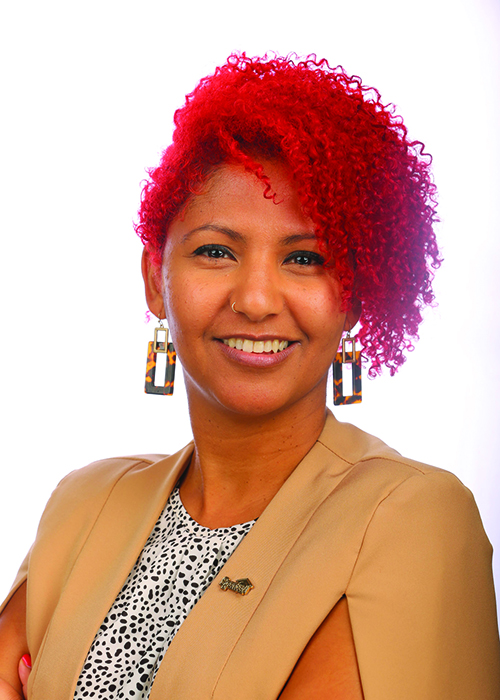A young woman embraces her
authenticity and overcomes barriers
to carve out her place in the industry’s nonprofit sector
By Elisabeth Boone, CPCU
“I was in a math class in college and the student sitting next to me asked if I’d heard of actuarial science,” Tandeka Nomvete recalls. “I was intrigued because I was not aware of it. I did some research and learned that it was the top pick among recruiters and paid six-figure salaries. I was hooked!”
In her senior year at Georgia State University, Nomvete landed an internship with a leading company in the commercial insurance brokerage sector. After graduation, she continued working for the national brokerage for several years in what could accurately be described as a typical corporate environment.
“Five years into my corporate career, I was intrigued by a different career path within the nonprofit sector of the risk management and insurance industry and made the switch to that part of our business,” she recalls. “Once it did that, I knew I’d found a space where I could truly thrive, because I felt that I could bring my authentic self to work,” she explains.
Where she landed is the Spencer Educational Foundation—a nonprofit organization that supports the education of future leaders in the industry. The organization supports the talent pipeline for all aspects of the industry by supporting students who are pursuing careers in risk management, insurance, and actuarial science.
Spencer was established 46 years ago, and it’s estimated that the institution has impacted over 110,000 students, primarily across the United States and Canada. Nomvete has been with Spencer for three years, and this is the third director-level role she has held in her 10-year career.
Spencer has several grant programs and awards merit-based scholarships to high-ranking students. The institution offers experiential learning opportunities for students to learn more about risk management and insurance (RMI) outside of the classroom. “All of our efforts help to attract and retain talent for the entire RMI industry,” Nomvete says.
In her role as the director of external engagement, Nomvete helps spread awareness about the organization and ensures that its stakeholders are engaging with the institution. “Our stakeholders vary, from students at colleges and universities across the U.S. and Canada, to professors and other university representatives, to companies, donors, and other nonprofit entities that we partner with,” Nomvete explains.

“Throughout the last decade, I’ve observed some positive shifts in attitudes towards women, but I believe we still have a long way to go. There is still a disparity in the number of female CEOs in our industry. It’s still uncommon to see women of color in leadership roles.”
—Tandeka Nomvete
Director of External Engagement
Spencer Educational Foundation
“I truly enjoy my job! I not only get to award funding through our various programs, but I also get to change the trajectories of students’ future careers by building professional development and other opportunities for them.
“My external-facing role enables me to travel across the United States to attend industry events, enhancing Spencer’s brand awareness and creating new partnership opportunities with companies and other organizations,” Nomvete explains. “One of my favorite aspects of this industry is the variety of career paths available, including the nonprofit sector in which I work.”
Glass ceiling
“I think that most women in our industry eventually face some type of glass ceiling,” Nomvete asserts. “For example, most client service roles in our industry are held by women; many women in these roles find that they lack opportunities for advancement to more complex and higher-paying roles or managerial positions where they would have greater visibility, not only within the organization but also with clients.
“As you climb the corporate ladder,” she adds, “you’ll find that the higher you go, the greater the likelihood of encountering more men in the higher-paying roles.
“I remember, as an intern, looking around the office and wondering, ‘Where are the women in leadership positions?’ I was looking for people to look up to; I was searching for individuals in high-ranking roles with whom I shared commonalities to understand what their career journeys were like and how they got to where they were.
“It was disheartening not to see someone who looked like me in a leadership position in this industry,” Nomvete continues. “What that did, subconsciously, was make me question whether there was any opportunity for me to grow within this industry and if this was the right place for me.”
Nomvete’s early professional experiences were disheartening regarding attitudes toward women. “As an intern, I remember attending a baseball game where I was the only female intern. I watched the male professionals approach the male interns, handing them their business cards and offering to assist them in their careers.
“They just ignored me, leaving me feeling invisible after that experience,” Nomvete shares.
“Regardless,” she continues, “I refused to let any discouraging experiences hold me back; instead, I worked even harder to stand out and become difficult to ignore, which I hope will create more opportunities for young women who look like me.
“Throughout the last decade in this industry, I have observed some positive shifts in attitudes towards women, but I believe we still have a long way to go,” Nomvete notes. “There is still a disparity in the number of female CEOs in our industry.
“It’s also uncommon to see women of color in leadership roles. Although I do believe improvement is happening, it’s just occurring at a slow pace.”
Leadership qualities
What unique qualities does Nomvete think women bring to positions of leadership in the industry? “I think women tend to bring more empathy, kindness, caring, and humility to leadership positions than our male counterparts do,” Nomvete responds.
“Women know what it means to juggle multiple responsibilities—home, family, children, religious activities, work, volunteer positions—and women tend to take on more roles within the family unit, like caring for aging parents,” she adds.
“It might be a generalization, but I believe that having this fundamental understanding—that work is just a part of our lives, not all of our lives—enables women to be more empathetic and not treat employees like robots.”
From the standpoint of a woman in a leadership position, how would Nomvete characterize the opportunities for women in this field? “With baby boomers retiring and 350,000 available jobs in our industry, the opportunities are limitless,” she states. “Younger individuals are consistently being promoted at a quicker pace, making this a fantastic opportunity for more women to enter our field and aim high.
“I love that we have this chance for the next generation of talent to rise up and contribute fresh perspectives and innovative ideas to change old company habits,” she adds.
“I’m excited about the future of this industry and look forward to a time when seeing a woman, especially a woman of color, in a leadership role won’t be unusual,” Nomvete concludes.
The author
Elisabeth Boone, CPCU, is a freelance journalist based in St. Louis, Missouri.






